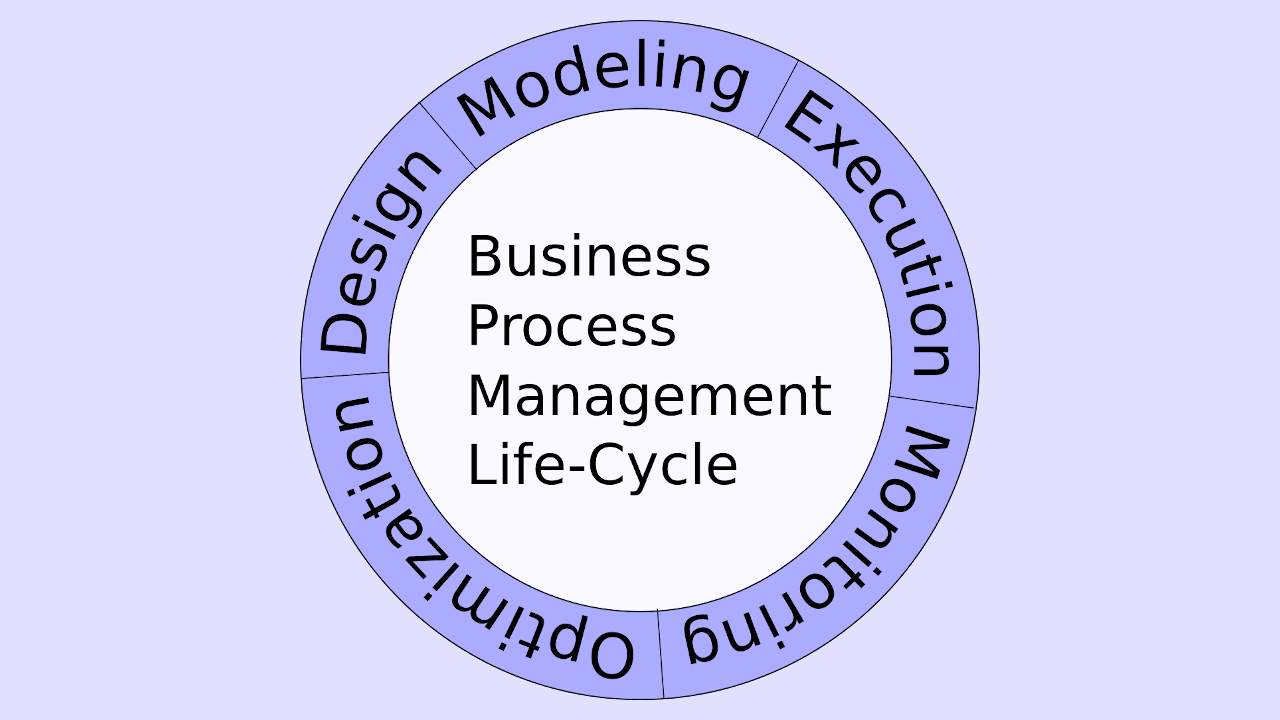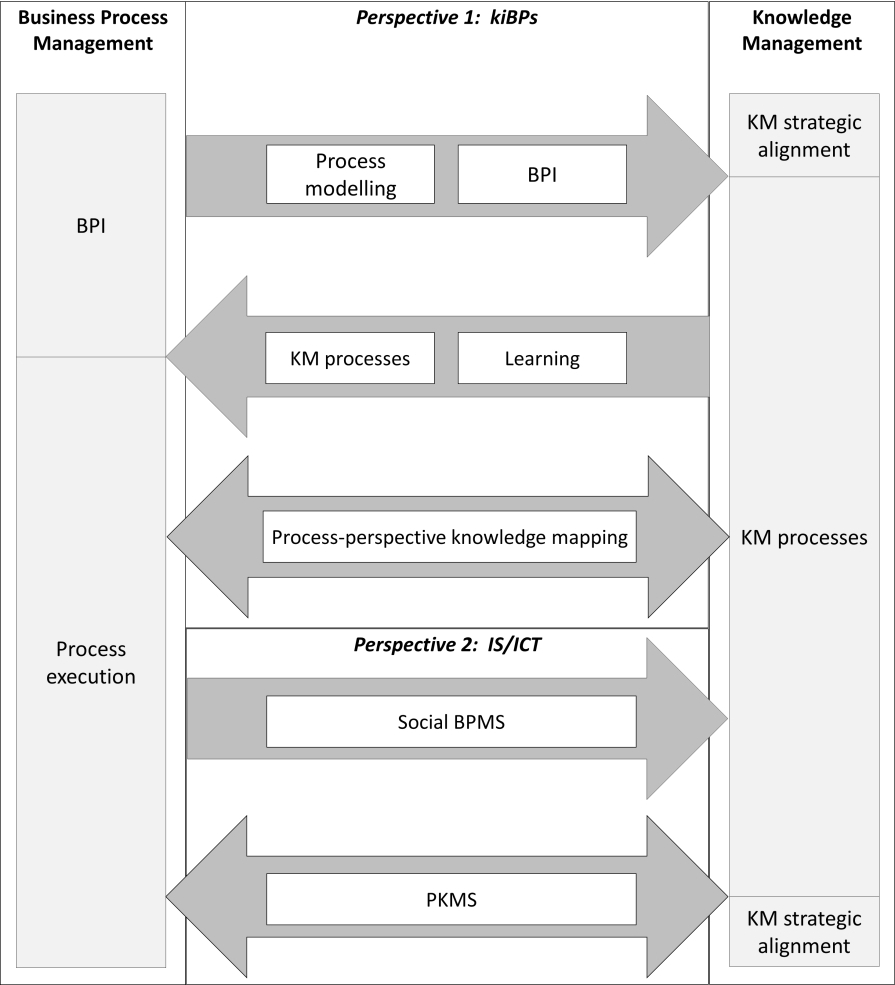
What is the relationship between knowledge management (KM) and business process management (BPM)?
Business process management (BPM)1 is the discipline in which people use various methods to discover, model, analyze, measure, improve, optimize, and automate business processes. An important aspect of BPM is the BPM lifecycle, as shown in the image above. The elements of the lifecycle are:
Design – Process design encompasses both the identification of existing processes and the design of “to-be” processes.
Modeling – Modeling takes the theoretical design and introduces combinations of variables.
Execution – Business process execution is broadly about enacting a discovered and modeled business process.
Monitoring – Monitoring encompasses the tracking of individual processes, so that information on their state can be easily seen, and statistics on the performance of one or more processes can be provided.
Optimization – Process optimization includes retrieving process performance information from modeling or monitoring phase; identifying the potential or actual bottlenecks and the potential opportunities for cost savings or other improvements; and then, applying those enhancements in the design of the process.
Highlighting the extent to which BPM has become established as an organizational approach, the Association of Business Process Management Professionals (ABPMP) International has established a BPM Common Body of Knowledge and BPM Competency Model, and connects over 17,000 individuals representing more than 750 corporations and 56 chapters worldwide.
Given this, the relationship between knowledge management (KM) and BPM should be explored. A paper2 presented at IFKAD 2021 documents initial steps in this regard. The paper authors report on the findings of a systematic review looking at the overlap between KM and BPM.
A keyword search of Business Process Management Journal and the Journal of Knowledge Management followed by exclusion and eligibility screening led to the identification of 31 articles for analysis. The authors acknowledge the limitations imposed by focusing on just two journals, although they are key journals in each field, and in response, plan to widen their future research to include other journals.
Nine main themes emerged from the analysis: learning, natural integration, business process improvement (BPI), KM processes, KM strategic alignment, process modeling, process-perspective knowledge mapping, information systems / information and communication technology (IS/ICT), and knowledge-intensive business processes (kiBPs).
The kiBPs are characterized by high complexity and knowledge intensity, and examples are the innovation process, coordination process, creative problem-solving process, customer relationship management (CRM) process, and knowledge management. The kiBPs are seen as distinct from IS/ICT processes. The reviewed articles show IS/ICT as comprising process-oriented KM systems (PKMS) and social BPMS (sBPMS). sBPMS refers to the engagement of relevant stakeholders throughout the BPM lifecycle through the utilization of social software.
Based on their analysis, the systematic review authors suggest a framework that can be used to structure current and future research in the overlapping themes of BPM and KM. As shown in Figure 1, the framework includes the two perspectives of kiBPs and IS/ICT, and three types of relationship between BPM and KM: BPM influences KM, BPM is influenced by KM, and BPM and KM mutually influence each other.

Findings from the reviewed articles that have informed the framework include:
- process modeling has a positive impact on knowledge sharing
- BPM has a facilitating role in regard to the externalization and internalization of knowledge
- BPM positively influences KM strategic alignment
- business processes align KM strategy with enterprise business strategy
- KM processes (i.e., knowledge acquisition, knowledge creation, knowledge sharing, and knowledge application) have a positive influence on the effectiveness of the business process improvement (BPI) activities (however, the prevailing research trend in this area is to focus primarily on knowledge sharing, ignoring other KM processes)
- KM supports learning in BPM, and several models have been developed in this regard
- the strength of KM processes on process improvement and execution rises along with the knowledge intensity of the business processes
- process-perspective knowledge maps integrate knowledge mapping and process modeling, and raise awareness of KM resources among the knowledge workers who execute these processes
- sBPMS positively influences KM, with sBPMS having a role in leveraging knowledge sharing
- PKMS support KM processes, including knowledge acquisition, creation/codification, sharing, application/utilization, with the role of knowledge repositories highlighted
- PKMS support KM strategic alignment
- PKMS personalizes the delivery of knowledge to processes, and ensures accessibility of knowledge sources, which positively influences process execution.
From their analysis, the authors also identify priorities for future research, aligned to the framework. These priorities are:
- the need to classify kiBPs, develop performance measures for kiBPs, and further investigate different aspects of KM support of kiBPs
- researching transferring KM processes from one BPI project to another
- adapting current BPM maturity models to capture aspects of kiBPs management
- studying the influence of knowledge acquisition, knowledge creation, knowledge application, and knowledge protection on process improvement, and linking KM processes with the stages of the BPM lifecycle
- studying the influence of various critical success factors, including BPM activities (e.g., process discovery, process modelling) and sBPMS on knowledge acquisition, knowledge creation, knowledge application, and knowledge protection.
Header image source: Aleksander Blomskøld on Wikimedia Commons, CC BY-SA 3.0.
References:
- Wikipedia, CC BY-SA 3.0. ↩
- Monashev, M., & Krčál, M. (2021). An Overlap of Knowledge Management and Business Process Management: a Systematic Literature Review. IFKAD 2021: Managing Knowledge in Uncertain Times. ↩
Also published on Medium.


This is an exceptional article. It is a challenge for organizations to convey business processes to employees, partners, suppliers, and customers in a language they know and understand. It is not enough to convey business process chains-of-reasoning using labeled designs, end users also need to know the “why” rationale that is inherent within each link of the processes. These include the dependencies, contingencies, and causal relationships and other knowledge and information that paints the entire conceptual picture. Most business processing applications (at least the ones that I have looked at), are not designed to accommodate this kind of n-dimensional thinking.
I also like how the BPM relates to KM. I love these cross-functional discussions because they drive the discussion to deeper levels. This is important because that is where the real insight nuggets are buried. Thanks for bring this to my attend Bruce. I am a small contributor to your cause and would like to encourage others to contribute as well.